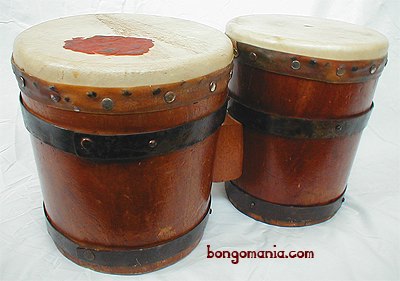 |
|
Articles |
Changüí: I am not an expert on Changüí, so this page will just present an overview of the basic elements of this interesting bongo-based music. Some of the information here comes from Matthew Dubuque, who travels to Oriente de Cuba frequently. Changüí is a very old musical style from the eastern mountains of Cuba. Some books describe it as a form of son, but that is not exactly correct. Changüí predates son, and it is not based on the son clave. In son and salsa the rhythm section is expected to maintain the structure of a tune's rhythm for the other instruments to solo over, while in changüí all of the instruments work together to create the overall rhythmic structure. Each of the musical parts is simple, but they combine to create a complex tension of three beats against four in every bar. The typical changüí group lineup includes bongos, marimbula (a large bass kalimba), maracas, metal güiro, tres, and singers. The maracas and güiro maintain an insistent pattern in 3/4 or 4/4, while the tres strides on the quarter notes and adds triplet phrases. The vocals are phrased similarly to the tres. The marimbula provides a sparse bass line emphasizing the one and the three but leading the beat. What about the bongos? Changüí bongos are different from modern bongos: they have much deeper shells, and the heads are glued and tacked on instead of using rims and lugs. They are even held differently, with the hembra on the left. The playing is completely improvised; it is rare to hear a steady pattern like the martillo in changüí. The improvisations are based on the polyrhythmic phrasing of the other instruments. Therefore it is impossible to notate a changüí bongo pattern. The only way to learn changüí bongo is to listen to the other instruments. Here is a very old pair of changüí bongos from Oriente de Cuba:
Notice the red material on the hembra head. It's called "fadela", and it's a traditional clay mixture which changes the tone of the drum head. There are several excellent changüí CDs available. The ones I have are: "Llegaron los Changüiceros" by Grupo Changüí de Guantánamo (on the Lucho label), and a compilation called "¡Ahora Si! Llego el Changüí", on the Corason/Caribe label. My technical description of the musical parts is based only on listening to these CDs. If you are a changüicero and would like to help out, please share what you know via the Contact page, and I will happily update this article. ¡Ahora si! |
| All contents of this site copyright 2004-2007 Cyrus Joaquin Heiduska, unless otherwise indicated | |
